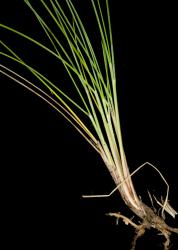- Taxon
- Gallery
Smooth soft to stiff green or glaucous tufted or occasionally shortly stoloniferous grass with long wide-angled inflorescences of evidently awned florets held high above hexagonal leaf-blades from swollen collars. Branching intravaginal. Prophyll 2–6 cm, brown, chartaceous, keels stiffly ciliate. Leaf-sheath (3)–9–11 cm, glabrous, keeled centrally, ridged elsewhere, much wider than leaf-blade, stramineous, margins becoming membranous; apical auricles 0.6–1.5 mm, rounded, shortly ciliate. Ligule as for auricles. Collar conspicuously thickened. Leaf-blade 10–20–(30) cm × 0.5–0.8 mm diam., hexagonal rarely circular, ribbed, abaxially glabrous except scabrid tip rarely minutely scabrid elsewhere, adaxially and on margins abundant short, white hairs; TS: 5 vascular bundles, 7 widely spaced sclerenchyma strands, rarely fewer, costal sclerenchyma very rare. Culm 25–45–(100) cm, usually » leaves, nodes often geniculate below, uppermost node conspicuous, black, internodes smooth, often slightly scabrid below inflorescence node. Panicle (7)–10–20 cm, with (5)–7–10 nodes, of 15–30–(50) spikelets, open with pulvinate widely divergent often flexible branches which may contract, basal branches 2–6–(10) cm solitary or occasionally binate, with 3–4–(5) spikelets, naked below, branches becoming progressively shorter and uppermost 3–4 spikelets solitary on short pedicels; rachis, branches and pedicels prickle-toothed to sparsely so becoming smooth or almost so. Spikelets (9)–14–20 mm × 3–4–5 mm wide, stramineous or sometimes bronze or slightly purpled, of (4)–5–8 florets. Glumes unequal, keeled, centrally green to stramineous occasionally with purpled veins, long triangular acute to obtuse, apex ciliate; lower (3)–4.5–6 mm, l-nerved, upper (3.5)–4–6–(8) mm, 3–(5)-nerved. Lemma 5–8–(9) mm, lobes 0 or very small, rounded on back becoming keeled above, prickle-teeth below on outer nerve and on margin, and above near awn; awn (1)–2.5–3–(4) mm. Palea 4.5–6.7–(9) mm, frequently < lemma, long acute, deeply (0.5–1.0 mm) bifid, keels prickle-toothed to base or almost so, interkeel hairs mostly in upper ⅓, margins of flanks ciliate above sometimes to base. Callus 0.2–0.4 mm, centrally glabrous very shortly bearded laterally; articulation oblique to ± flat. Rachilla 1–1.6 mm, short stiff hairy. Lodicules (0.6)–1.0–1.5 mm, ≥ ovary, often lobed, frequently hair-tipped. Anthers (2.0)–3–4.0 mm, yellow or yellow and purpled. Gynoecium: ovary 0.6–1.0 mm, hispid hairs at apex; stigma-styles 1.5–2.5 mm. Caryopsis 3–4 mm; embryo 0.5–0.75 mm; hilum 2 mm.
[From: Edgar and Connor (2000) Flora of New Zealand. Volume 5 (second printing).]




